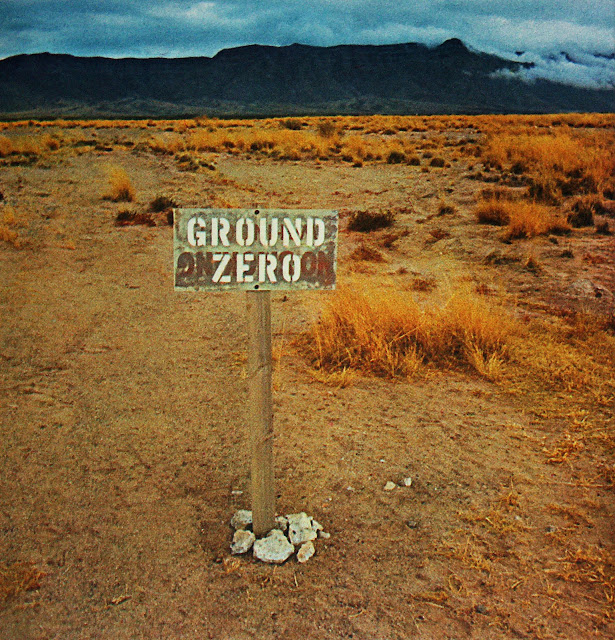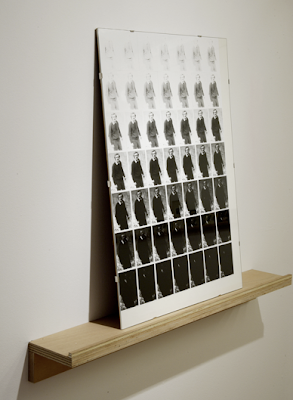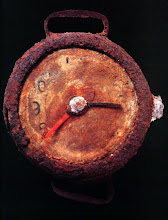Vangelis Vlahos, The Differences between the Parts Are the Subject of the Composition, 2009.
This and the following post introduce here the work of artist Vangelis Vlahos, whose researches and installations probe recent Greek history by combining architectural models and photographic archives. The presented three-part project, with Vlahos’ own textual notes, was installed in The Breeder in Athens in 2009. The essay in the following post is a commentary on Vlahos’ project by artist and theorist Kostis Stafylakis.
GR
The models depict Piraeus Tower, an abandoned high-rise building in Piraeus port, Greece. In each model of the Piraeus Tower the number of the building’s floors alters. Taking into account the modernistic design of the Tower, the models appropriate the grid structure of its minimal skeleton in order to produce an almost symmetrical composition of 6 different pieces with seemingly regulated changes. The images in the archive involve [PASOK Prime Minister] Andreas Papandreou's personal "mediation" between France and Libya over arrangements for bilateral troop withdrawals from Chad, in a summit meeting in Elounda Bay, in Crete, on November 15, 1984. The photos, taken from different media, depict Papandreou, Mitterrand and Gaddafi seating around a table. All the photos depict the same scene from different angles of view.
The title of the project is based on a found sentence from Sol LeWitt’s text “Serial Project No.1 (ABCD),” Aspen Magazine, 5-6 (1966)
About the Piraeus Tower: Piraeus Tower is a 24-story high-rise building in Piraeus port, technically the second tallest building in Greece. Architecturally the building follows the rules of the American International Style. Originally the building was planned to become a business and trade center similar to the World Trade Center in NY and be operated in a similar manner by the Piraeus Port Authority. Although the building was planned to serve as an icon signifying the progress Greece was making during the years of the military Junta (1967-1974), after the completion of its frame in 1974, it was never fully used apart from the first two floors, which have been occupied by a toy store, a home electronics chain and a school. The last serious development to the 24-story frame came in the early 1980's where it was gladded with glass and marble but without any other development on its frame.
This and the following post introduce here the work of artist Vangelis Vlahos, whose researches and installations probe recent Greek history by combining architectural models and photographic archives. The presented three-part project, with Vlahos’ own textual notes, was installed in The Breeder in Athens in 2009. The essay in the following post is a commentary on Vlahos’ project by artist and theorist Kostis Stafylakis.
GR
The models depict Piraeus Tower, an abandoned high-rise building in Piraeus port, Greece. In each model of the Piraeus Tower the number of the building’s floors alters. Taking into account the modernistic design of the Tower, the models appropriate the grid structure of its minimal skeleton in order to produce an almost symmetrical composition of 6 different pieces with seemingly regulated changes. The images in the archive involve [PASOK Prime Minister] Andreas Papandreou's personal "mediation" between France and Libya over arrangements for bilateral troop withdrawals from Chad, in a summit meeting in Elounda Bay, in Crete, on November 15, 1984. The photos, taken from different media, depict Papandreou, Mitterrand and Gaddafi seating around a table. All the photos depict the same scene from different angles of view.
The title of the project is based on a found sentence from Sol LeWitt’s text “Serial Project No.1 (ABCD),” Aspen Magazine, 5-6 (1966)
About the Piraeus Tower: Piraeus Tower is a 24-story high-rise building in Piraeus port, technically the second tallest building in Greece. Architecturally the building follows the rules of the American International Style. Originally the building was planned to become a business and trade center similar to the World Trade Center in NY and be operated in a similar manner by the Piraeus Port Authority. Although the building was planned to serve as an icon signifying the progress Greece was making during the years of the military Junta (1967-1974), after the completion of its frame in 1974, it was never fully used apart from the first two floors, which have been occupied by a toy store, a home electronics chain and a school. The last serious development to the 24-story frame came in the early 1980's where it was gladded with glass and marble but without any other development on its frame.
In the past there have been many rumours about the cause of its incomplete construction status, including an engineering mistake or miscalculation that greatly affected the building's overall stability. However, nothing of the above has ever been confirmed officially.
The particular building along with a series of other initiatives, investments and infrastructure works held during the period of the dictatorship tried to create the impression both in Greece and the West that Greece is a modern country which could play a leading role in the wider area of the Mediterranean and Eastern Europe.
The particular building along with a series of other initiatives, investments and infrastructure works held during the period of the dictatorship tried to create the impression both in Greece and the West that Greece is a modern country which could play a leading role in the wider area of the Mediterranean and Eastern Europe.
The Elounda Summit (The differences between the parts are the subject of the composition), 2009. About Greece’s relationship with the Arab World: Greek governments have traditionally pursued a policy of friendship with the Arab states. This relationship is based on both historical and contemporary factors. In the wake of the oil crisis and the Turkish invasion of Cyprus, both in the mid-1970s, Greece's Middle East policy appeared to slant strongly toward the Arabs. This seems to be dictated by two needs: for Arab support for Greece's Cyprus policies and for stable oil supplies from the Arab oil producers. After the fall of the Greek dictatorship in the mid 1970s, Greece asserted its intermediary role between the Middle East, North Africa and the European Community hoping to become an economic and financial centre and a crossroads in the region. In the early 1980s, the Papandreou socialistic governments continued this policy, establishing close relations with most of the so called at that time radical regimes of the Middle East such as Syria, Libya, PLO etc. The PLO was granted recognition at the end of 1981; closer relations were cultivated with Libya and Algeria; Papandreou visited a number of Arab countries; a direct line of communication was established between Greece and Syria; and an agreement was signed with Syria against world imperialism and racist Zionism. Papandreou’s initiative to invite Mitterrand and Gaddafi to discuss an issue not directly connected to Greece’s affairs can be seen in the context of a broader Greek foreign policy at that time to play an intermediary role between the West and the Arab world.
Kostas Kotsakis (The differences between the parts are the subject of the composition), 2009. The photographs depict Greek architect Kostas Kotsakis, whose name was found in the agenda of an associate killed during a bomb attack attempt against the American embassy in Athens in September 1970. This project is presented as a grid of 49 small size b&w photographs where the amount of light is progressively reduced. The title of the project is based on the same found sentence from Sol LeWitt’s text cited above.
About Kotsakis: Although not widely known, Kostas Kotsakis (64 years old today) took an active role in the fight against the Colonels’ Junta. After the capture of the active members of the November 17 terrorist group in the summer 2002, Kotsakis was represented in the Greek press as linked to terrorist networks. According to reports at the time, he seemed to be a member of the Epanastatikos Laikos Agonas (Revolutionary People's Struggle, known by the acronym ELA). After the group November 17, ELA was the most important terrorist group of the Greek radical Left. Kotsakis’ name was also found in the archives of the Stasi, the former East German secret police, connecting him with the terrorists Carlos the Jackal and Weinrich. Kotsakis denied any link with ELA and none of the above allegations was ever confirmed.
For the record, according to his own statements, Kotsakis had only a supportive role in the bombing attempt against the American embassy in Athens in September 1970. The attempt failed because of a defect in the bomb mechanism, which killed his companions Giorgos Tsikouris and Maria Elena Angeloni. Kotsakis’ name was found in Tsikouris’ agenda, and the regime declared him a co-perpetrator, putting a reward of 100,000 drachmas on his head. He succeeded in fleeing to Paris and did not return to Athens until 1975, after democracy had been restored.
Both November 17 and ELA developed out of the opposition to the military Junta and both groups were widely identified with the period after its fall in 1974. They were both strongly anti-American and sought the removal of US military forces from Greece. Until the end of the 1980s their activities and declarations were to a certain extent viewed favourably by the Greek people. ELA ceased its activity in 1995, while the November 17 group was disbanded in 2002, the period before the Olympic Games in Athens.
Photos courtesy of the artist and The Breeder, Athens:
The Piraeus Tower (The differences between the parts are the subject of the composition), 2009. Six scale models 1:150 on a wooden base (210 x 135 x 15cm).
The Elounda summit (The differences between the parts are the subject of the composition), 2009. Eight press photographs on a wooden shelf (c. 2.5 m).
Kostas Kotsakis (The differences between the parts are the subject of the composition), 2009. Forty-nine photographs (6.5 x 9.5cm each) in glass frame 50 x 70cm.






No comments:
Post a Comment